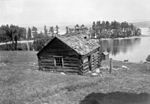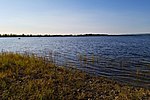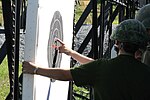Horaceville, Ottawa
Horaceville is a historic site located on the Ottawa River in eastern Ontario, Canada. The site remained the property of the heirs of Hamnett Kirkes Pinhey until the 1970s, when the property was sold to the township. Today, The 88-acre (360,000 m2) heritage site is owned and operated by the City of Ottawa and Pinhey's home serves as a museum. The museum is open May 14 through August 31, Wednesdays to Sundays, 11 am to 5 pm. This location is also known as Pinhey's Point Historic Site. The property was designated by the City of Ottawa under Part IV of the Ontario Heritage Act as having cultural heritage value or interest. A bronze plaque erected on the site by the Ontario Heritage Foundation describes the property's history: "Hamnet Kirkes Pinhey 1784 - 1857 - A merchant and ship owner in his native England, Pinhey came to Upper Canada in 1820. For his services as King's messenger during the Napoleonic Wars, he received a 1000 acres land grant on the Ottawa River. Within a decade he had built up an estate which he named Horaceville after his elder son. In addition to a manor house and barns, it included mills, a store and church. Pinhey took a leading part in township and district affairs. He was appointed to the Legislative Council in 1847, served as Warden of the Dalhousie District, and as the first Warden of Carleton County. Horaceville remained in family hands until 1959 when it was purchased by the National Capital Commission."The site, which is a popular destination for boaters, cyclists, and picnics, consists of 88 acres (360,000 m2) of park land, a nearly 200-year-old stone manor house, two barns, scenic views of the River and several stone ruins. The manor house acts as a historic house museum with furnished rooms and temporary exhibits. The City of Ottawa offers multiple programs for families throughout its operating season (May - August) as well as some programs in the off-season. The park itself is open year-round. Admission to the museum is by donation; some of the programs and special events charge a small fee for participation. The venue can be rented for weddings, anniversaries, or any other special celebration.
Excerpt from the Wikipedia article Horaceville, Ottawa (License: CC BY-SA 3.0, Authors).Horaceville, Ottawa
Pinhey's Point Road, Ottawa Kanata (West Carleton-March)
Geographical coordinates (GPS) Address Nearby Places Show on map
Geographical coordinates (GPS)
| Latitude | Longitude |
|---|---|
| N 45.438888888889 ° | E -75.952777777778 ° |
Address
Pinhey's Point Road 269
Ottawa, Kanata (West Carleton-March)
Ontario, Canada
Open on Google Maps




